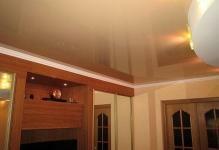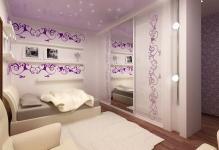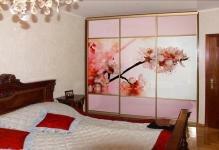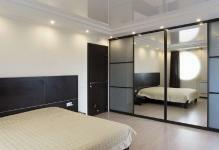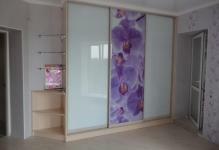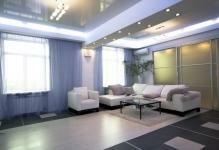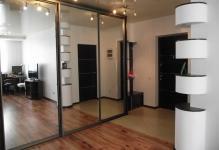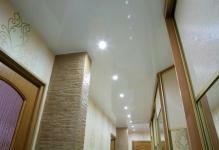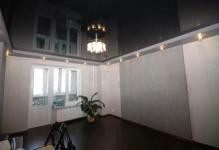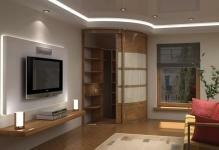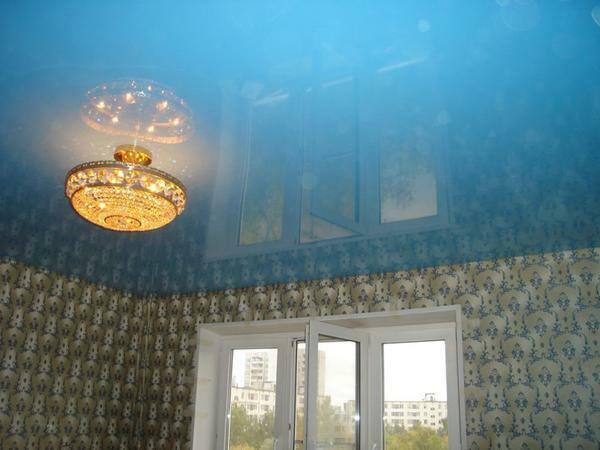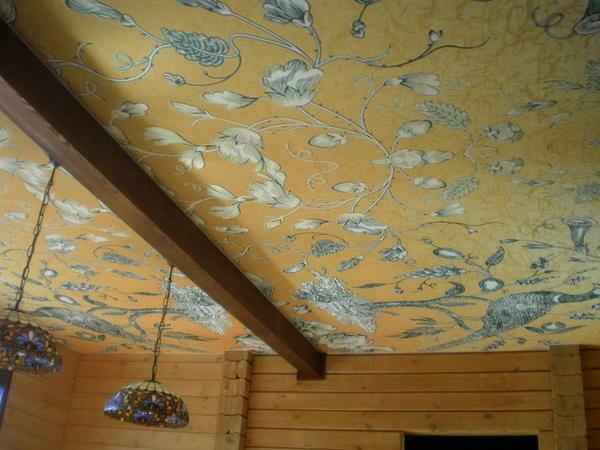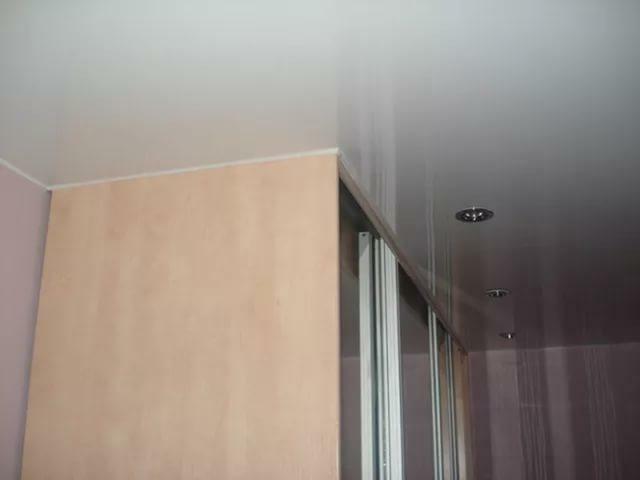 It is necessary to do everything strictly according to the level, since the difference in height between the floor and ceiling slabs at different ends of the room will be different The stretch fabric is one of the most common materials for ceiling finishing. It is a thin enough but strong film. However, it can easily be damaged by a sharp object. Another stylish and comfortable element of the interior is the built-in closet. It fits perfectly with modern designs. To connect in one room the built-in furniture and the stretcher, you need to know a few nuances.
It is necessary to do everything strictly according to the level, since the difference in height between the floor and ceiling slabs at different ends of the room will be different The stretch fabric is one of the most common materials for ceiling finishing. It is a thin enough but strong film. However, it can easily be damaged by a sharp object. Another stylish and comfortable element of the interior is the built-in closet. It fits perfectly with modern designs. To connect in one room the built-in furniture and the stretcher, you need to know a few nuances.
-
- What to do first: stretched ceiling or cabinet
- Stretch ceiling and built-in cabinet: how to combine correctly
- Sliding wardrobes built-in under the suspended ceiling: separate
- Built-in coupe for ceiling thatSurrounds the cabinet
- How to combine the closet and the suspended ceiling( video)
- Examples of cabinets under the suspended ceiling( photo in the interior)
What to do first: stretch ceiling or cabinet
Doing repairs, We often most often first deal with the decoration of walls, floors and ceilings, and only then we proceed to the selection of furniture. However, this approach is not entirely correct, if you immediately draw up a design project for the room, thinking about what material to use for its decoration and what furniture there will fit in, the interior will look much more harmonious. Also, you avoid the many problems that can arise when installing embedded furniture.
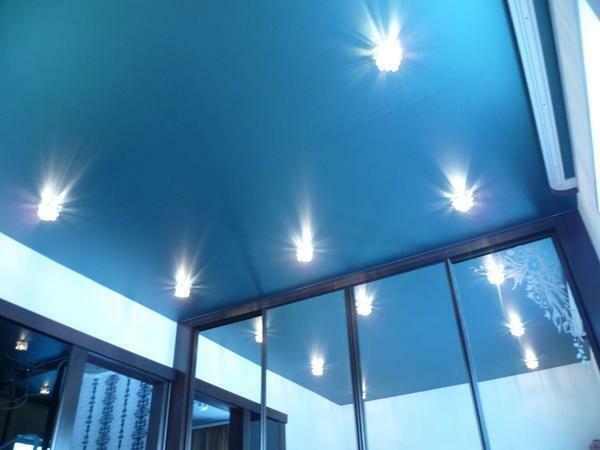 The most acceptable and most suitable option is the simultaneous installation of a built-in compartment and a suspended ceiling design. The essence of this solution is simple and reliable - the cabinet itself acts as one of the sides for fixing the mounting rail
The most acceptable and most suitable option is the simultaneous installation of a built-in compartment and a suspended ceiling design. The essence of this solution is simple and reliable - the cabinet itself acts as one of the sides for fixing the mounting rail
When choosing for your home built-in cabinets, you first need to think carefully about what the ceilings will be in it. If you decide to decorate the room with a stretcher, you must initially decide what to install the first ceiling or cabinet. It depends on where the furniture will be installed, and how it should be combined with the ceiling space.
How to combine a suspended ceiling with a built-in cabinet:
- The tensioning sheet can be in front of the cabinet. In this case, the cabinet has its lid not connected with the ceiling.
- The ceiling fabric can pass inside the cabinet. In this case, it is its lid.
- You can arrange a tensioning cloth around the cabinet. In this case, the structure looks uniform.
When considering which of these options to choose, pay special attention to the size of your closet and where it will stand. What to install earlier, the ceiling or the cabinet, depends on which of the installation methods suits you. In any case, the mortgage is established at the first stages.
Stretch ceiling and built-in cabinet: how to combine correctly
One of the most interesting options is the installation of the cabinet so that it is one with the ceiling. In this case, the canvas serves as its lid.
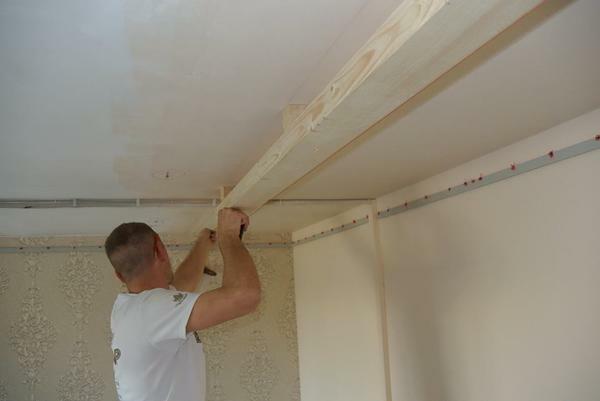 The situation is not insoluble. And the furniture coupe, and the tension structure can be combined without problems in a single room.
The situation is not insoluble. And the furniture coupe, and the tension structure can be combined without problems in a single room.
You can improve the design of the space inside the cabinet by mounting lighting on the film.
The main disadvantage of this installation, is that during the operation of the cabinet, you can accidentally damage the ceiling board. The second drawback is the need to dismantle the whole cabinet, in case of dismantling the ceiling.
How to make a cabinet with a tension ceiling of one design:
- First, a wooden beam is installed on the load-bearing ceiling. It needs to be fastened in the place where the cabinet doors will be located. In this case, the mortgage must not have any jaggies and irregularities as they can damage the canvas.
- Next, the frame is installed under the tensioning cloth, and also the installation and wiring of the lighting devices.
- A full stretcher is installed along the entire length of the room. A PVC plate is attached at the place of contact of the film with the bar.
- Now through this plate a rail for the doors of the cabinet is installed on the beam. It fixes the ceiling skirting.
- If necessary, lighting fixtures are installed in the cabinet and the doors are assembled.
This installation option is only possible if the cabinet occupies the entire wall. The place of transition of the ceiling to the cabinet can be decorated with LED tape, this will facilitate the appearance of the structure and will expand the space of the room.
Sliding wardrobes built-in under the suspended ceiling: separate
design If you decide to install a wall-mounted cabinet in the room, you can mount it in front of the tensioning sheet. Thus, despite the fact that the design will look like a single unit, the cabinet and ceiling will exist separately.
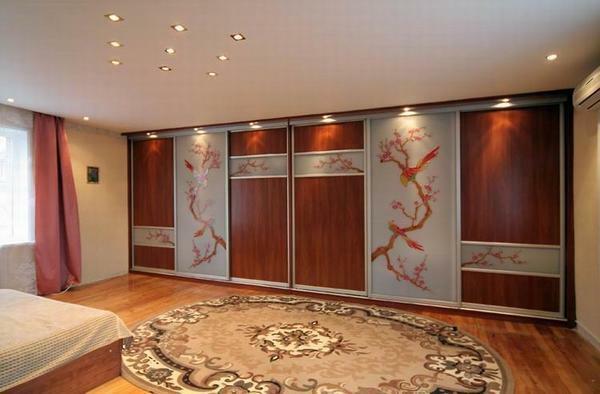 The coupe is ordered with the
The coupe is ordered with the
- at the level where the doors of the cabinet will be located will be fastened to its cover or specially applied additional strip., The bar is installed. At the same time, its lower plane must pass at the level of the tension web.
- A rail for doors and a baguette for fixing the tension web is mounted on the beam.
- Next, all the elements of the cabinet are assembled except the sliding doors.
- At this stage, the film is stretched.
- The sliding doors are the last to be installed.
If desired, you can install a decorative ceiling skirting over the door guide. So the design will look more elegant, but its performance properties will be lowered.
Built-in compartment for the ceiling that surrounds the cabinet
If your built-in furniture does not occupy the entire wall, but only a part of it, you can mount a tensioning cloth around the cabinet. It's quite a complicated process, but it looks impressive.
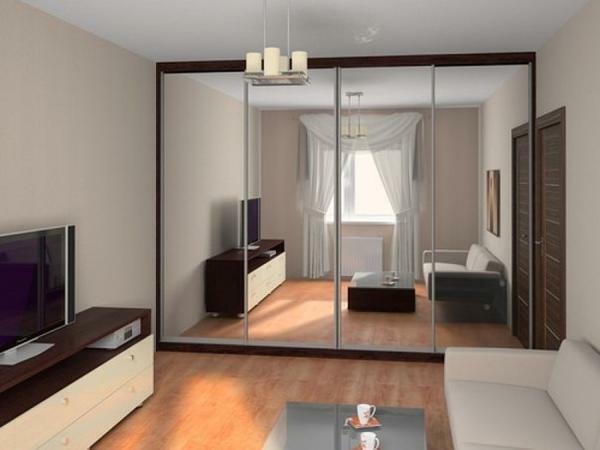 This type of construction has at least 2 advantages: there are no gaps and cracks above the roof of the cabinet and all internal filling of the cabinet up to the ceiling is involved.
This type of construction has at least 2 advantages: there are no gaps and cracks above the roof of the cabinet and all internal filling of the cabinet up to the ceiling is involved.
You can install small spotlights on the ceiling around the cabinet, this will enhance the effectModernity of design.
For such an arrangement of the room, the fabric must be made to order. It is not possible to cut the hole of the right size in the film yourself.
Stages of installation of a cabinet with a ceiling around it:
- The first thing is going to a box of bars and harpoon baguette. In it holes for fastenings are drilled at once.
- Fully assembled box with baguettes installed on the ceiling. Harpoon baguettes are attached to it.
- Next, the cabinet is assembled and the web is stretched.
This design is quite difficult to install, but in any case, the installation of a tensioner requires the help of a specialist. The built-in wardrobe with its surrounding stretch ceiling looks modern and stylish.
How to combine a wardrobe and a stretch ceiling( video)
The combination of a stretched ceiling with a built-in wardrobe is a very real task. The main thing is to think in advance which version of installation of this design suits you, and experienced masters will help to realize your dream.
